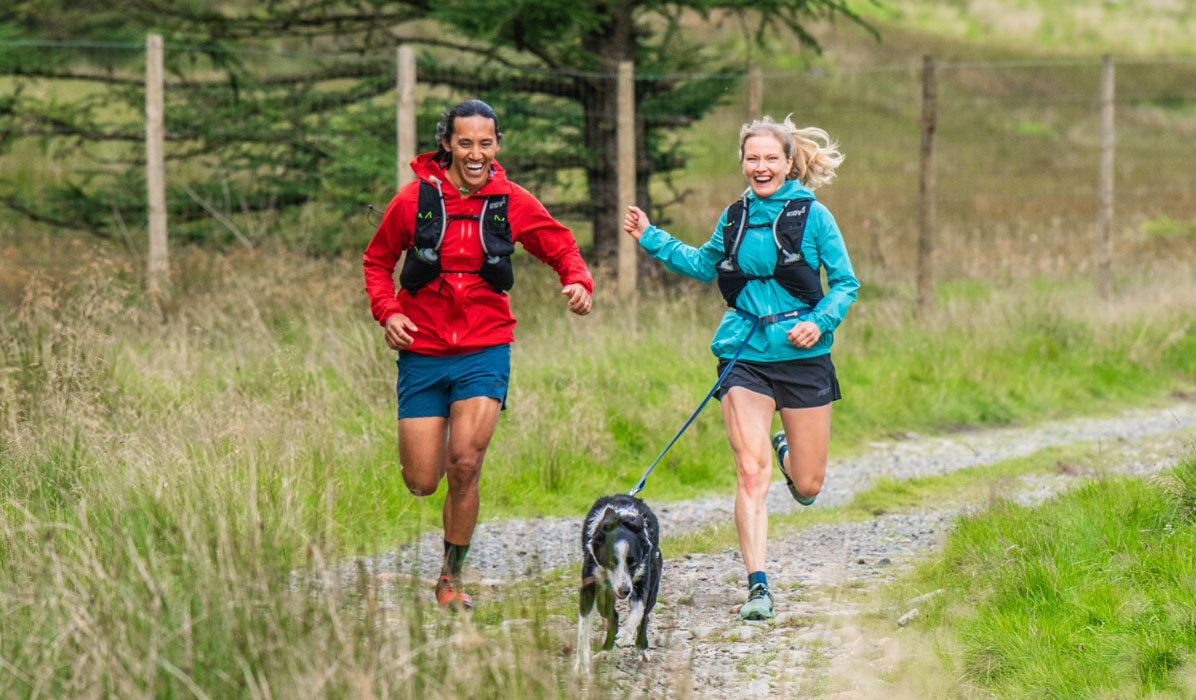
It’s time to upgrade walkies! Running with your dog is a fantastic experience – and a very fun way to tick off your training miles. It’s great for your pooch’s health too.
If you want to start running with your dog, our guide has all the information you need – including how to train your dog to run with you.
While you might assume that your dog has better running fitness than you, that may not necessarily be the case. Be sure to read the information in before you start for advice on how to safely start running with your four-legged friend.
WHY RUN WITH YOUR DOG?
A lot has been written about why running is good for humans – but it’s also great for dogs, for many of the same reasons! Running can help your dog:
- Maintain a healthy weight (or lose some)
- Improve its mental sharpness
- Reduce anxiety, stress and depression
Alongside these health benefits, running with your dog can strengthen the bond between you and your animal. It’s also a smart way for you to incorporate more vigorous exercise into a busy day.
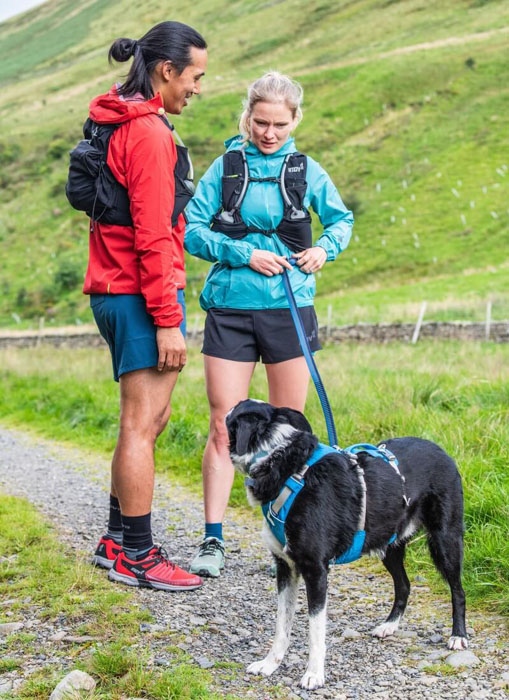
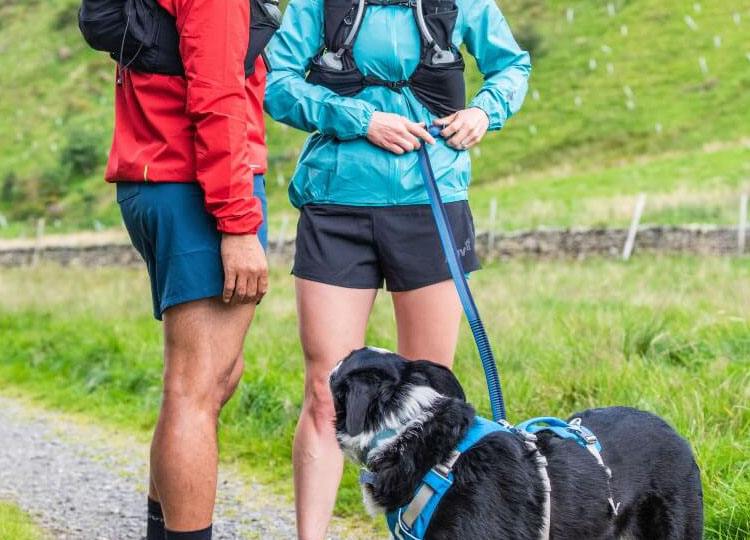
BEFORE YOU START
It’s important to speak to a vet before you start running with your dog.
Some breeds take to long distance running better than others. So if you’re thinking about running an ultra with your miniature dachshund, think again! Breeds that are typically better at running include labradors, huskies and collies – but your vet will give you an expert opinion on whether they think running is a good idea.
The age of your dog is also a factor – younger dogs may not yet be fully developed, and older dogs may need a longer period to adjust to a new exercise regime. If your dog is overweight, remember that running is going to place additional strain on its body – again, seek the advice of a vet before hitting the trails.
When planning routes to run on, think about the terrain. You want softer, bouncier ground – grass, soft trails and sand are great surfaces for your dog to run on. Limit the amount of concrete footpaths, road and rocky trails.
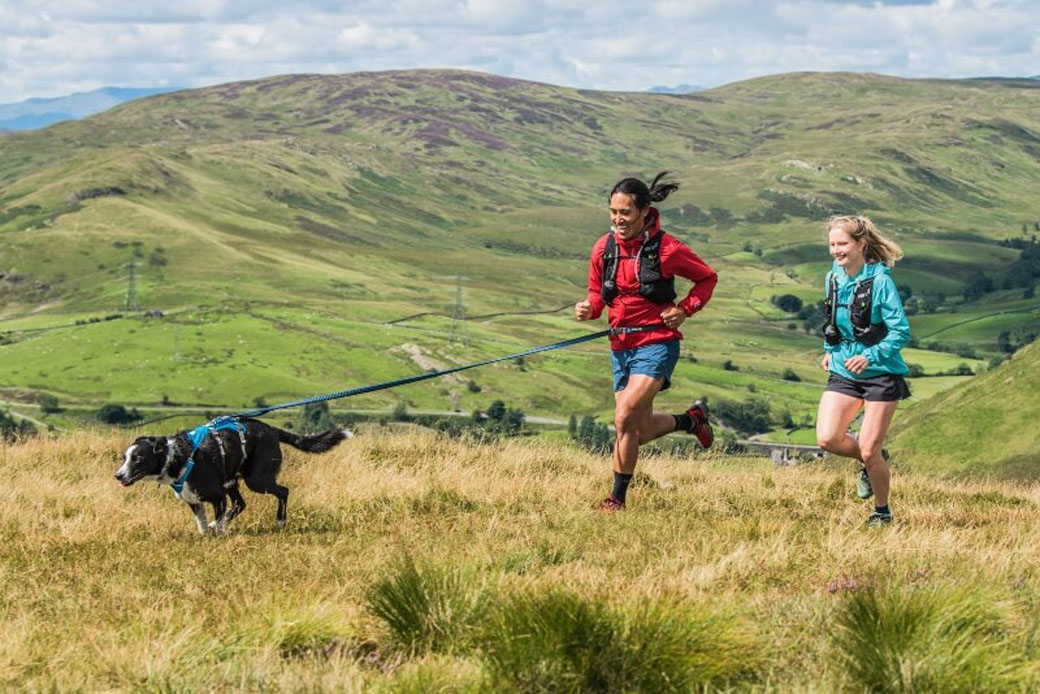
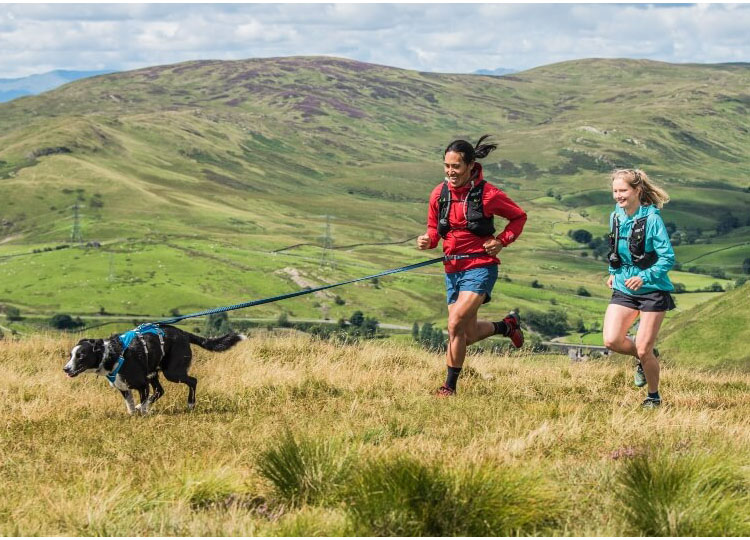
HOW TO TRAIN YOUR DOG TO RUN WITH YOU
When thinking about how to train your dog, it’s important to work on commands and cues to get them used to running with you, as well as building up the running slowly.
WALK BEFORE YOU RUN
If your dog pulls on the lead it could result in them pulling you over when running. So before your start running with your dog, you both need to have mastered loose lead walking.
You need to train your dog to find it more rewarding to stay near you on a loose lead. Treats, toys and praise all help to reinforce this message to your furry friend. If you’re intending to run with your dog off the lead, make sure that you can trust them to stay close to you.
The next step is to train your dog to walk on one side of you. It doesn’t matter which side it is, but you do need to consistently train them to walk on the same side. This is so that they don’t cut across you when running – that could result in you tripping over (or injury to you both if your dog is on the lead).
STARTING TO RUN TOGETHER
The first thing is to make it easy for your dog to understand that you’re going for a run. A different lead or harness for running can be useful here, as it’ll help your dog distinguish between going for a walk.
You then need to train your dog to start running when you want it to:
- Decide on a cue that lets your dog know to walk on – this could be something like “let’s go”.
- Next, decide on a cue that tells your dog that it’s time to run (for example “get running”).
- Alternate short bursts of running/walking using your cues to tell your dog what to do.
- Reward your dog when they respond in the correct way to the cues.
BUILDING UP YOUR DOG’S ENDURANCE
You might assume that your dog is already able to run further and faster than you. However, just like humans they need to train to build their endurance for longer distance running.
Start by introducing small sections of running into your walks. Over time, slowly increase the portion of your walk that’s spent running. Do this over a number of weeks to help them gradually adapt to running longer and longer distances. This time period will also help reinforce the running/walking cues you’ve taught them.
Think about the types of route you want to run with your dog. For example, if you want to run in the hills with them, then start slowly introducing this type of terrain into your walks. Try walking/running on unfamiliar trails too, so that you can be sure you can trust your dog on routes it doesn’t know.
When you’re running, run at your dog’s pace. If they’re struggling, slow down, walk, or take a break. If your dog isn’t enjoying running, don’t force them to do it.
WARM UP BEFORE EVERY RUN
Start with a quick walk for a few minutes – let your dog explore, sniff, and go to the toilet. Slowly increase the speed into a trot, then gradually increasing to a run at the end of the warm-up.
Dynamic stretching is as important for dogs as it is for us. By this we mean anything that exaggerates a natural motion – playing fetch and chasing after a ball for a few minutes is perfect.
ESSENTIAL KIT FOR RUNNING WITH YOUR DOG
If you’re hitting the trails with your pooch, you’ll want to make sure you’re well prepared. We’d advise you to have the following pieces of kit:
- Trail Running Shoes
It’s better to take your dog running off road. Depending on the types of surfaces you’re running on, we’d recommend the Parkclaw G 280 (a great choice for runs that involve a bit of road and trail), or the Roclite G 275 V2 (a great trail running shoe that can handle any type of terrain). - Dog Harness
A harness is an essential investment, as when running you’d want to attach the lead to your dog’s back or chest. Ruffwear’s Hi & Light™ Lightweight Dog Harness is a great option, as is the Trail Runner™ Dog Running Vest, which boasts a 2in1 harness and water carrying solution for your dog. - Lead
Even if your dog walks and runs off the lead, it’s worth carrying a lead just in case. Ruffwear’s Trail Runner™ Dog Leash is compact, lightweight and specifically designed for trail running using a dynamic stretch webbing. - Waist Pack
Depending on how far you’re going, you’ll need something to store your kit, water and food in. For shorter runs we’d recommend the Race Elite Waist Pack. This has ample storage for a collapsible dog bowl, valuables, a jacket, treats and poo bags. The Race Elite Waist Pack can also hold a 500ml Ultraflask (sold separately) to keep you and your dog hydrated. - Hydration Vest
For longer runs you’ll need to carry more. The Ultrapac Pro 8 offers eight litres of kit storage and comes with two 500ml flasks - one for you, one for your dog! - Collapsible Dog Bowl
The Ruffwear Trail Runner™ Ultralight Dog Bowl is a packable fabric bowl that can be stashed in a waist pack or hydration vest. - Poo Bags
For your dog, not you! Remember that the law of the trail is “leave nothing but footprints”. Consider double bagging and designating a “poo pocket” in your pack. Or let it swing – the pendulum motion can be quite therapeutic!
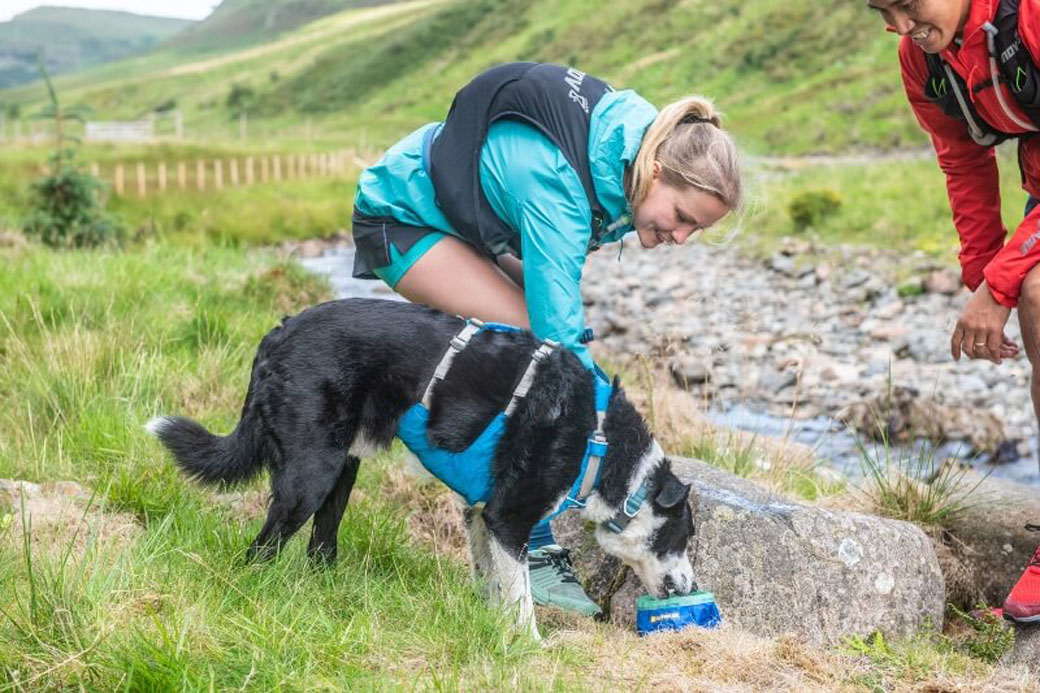
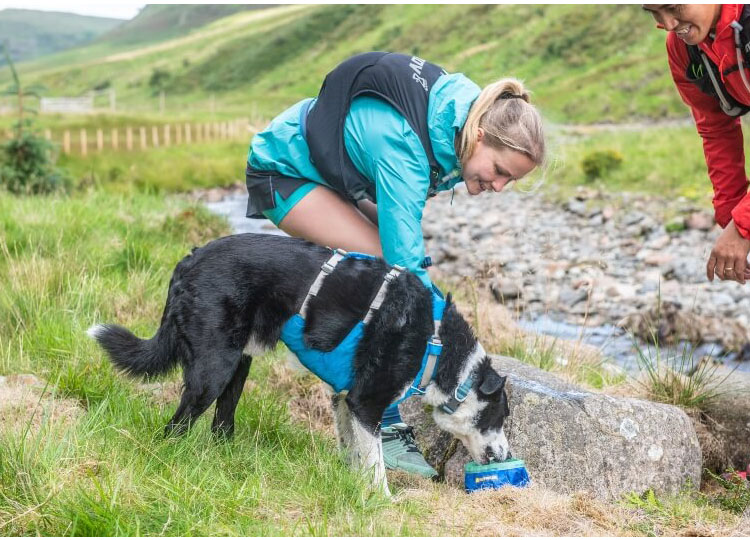
RUNNING IN HOT WEATHER
Dogs don’t sweat like we do – that means that they find it harder to cool down. If the temperature is over 20°C, don’t run with your dog.
In milder weather you can keep your dog cooler by:
- Going for your run in the early morning, or later evening.
- Adapting your route. Pick a route with plenty of shade, a breeze, and ideally somewhere appropriate that your dog can swim to cool down. The beach or a leafy park with a pond are great choices.
- Reducing the distance you are running. You may want to run slower too – and take more breaks than you ordinarily would.
- Carrying water, even on shorter runs.
Heatstroke can affect your dog, even in cooler weather. It’s essential that you know the symptoms of heatstroke and how to treat it. Check out this guide to heatstroke in dogs from the RSPCA.
RUNNING IN COLD WEATHER
The general rule here is “if it’s too cold for you, it’s too cold for your dog”. It’s always better to err on the side of caution. Remember that while your dog is covered in fur, they don’t have the benefit of running shoes or a thermal running jacket!
If you think it’s ok to run, then stick to a route that you know – ideally one with some bail-out options in case you need to cut the run short.
Winter can make the trails a sloppy place to be. If you decide to run on road, consider reducing the mileage to protect your dog’s joints. Whether you run on trail or road, make sure you wash your dog’s paws thoroughly after your run. You could consider getting some dog boots too, to protect them over the winter (Ruffwear’s Polar Trex™boots are a great option).

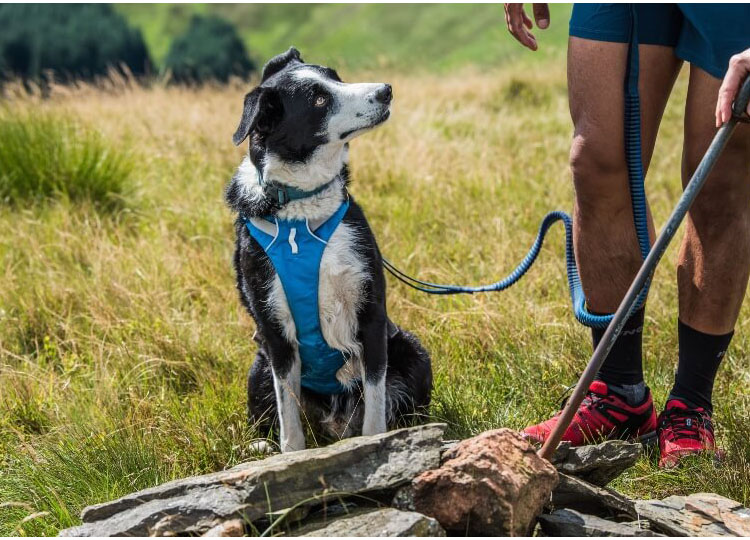
AFTER YOUR RUN
Dogs need to cool down too! Gradually reduce your pace to a walk at the end of your run, and then walk for several minutes. This helps bring your dog’s heart rate and body temperature down.
At the end of your workout, give your dog a drink – particularly if it’s a hot day (having extra water in your car is a good idea if you’re not ending your run at home). If your dog is cold/wet, towel them down as soon as you can and get them inside your car or home.
You might want to give your dog a muscle rub or help them stretch after a longer run.
Be vigilant for a few hours after your run for signs of heatstroke. Make sure they have access to plenty of water.
If your dog is a spaniel, expect to be brushing ears for the next seven hours.
Finally, create your dog an account on Strava and tag them in the run (optional).
